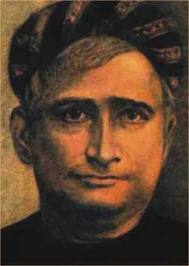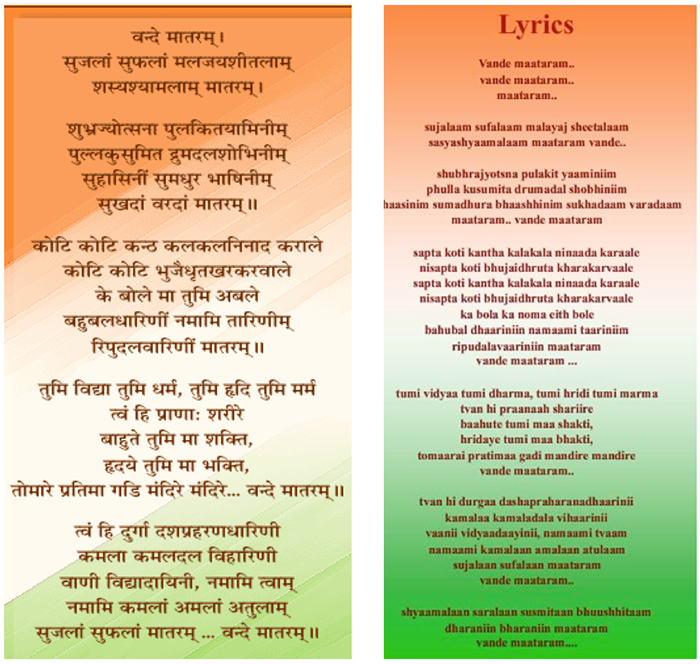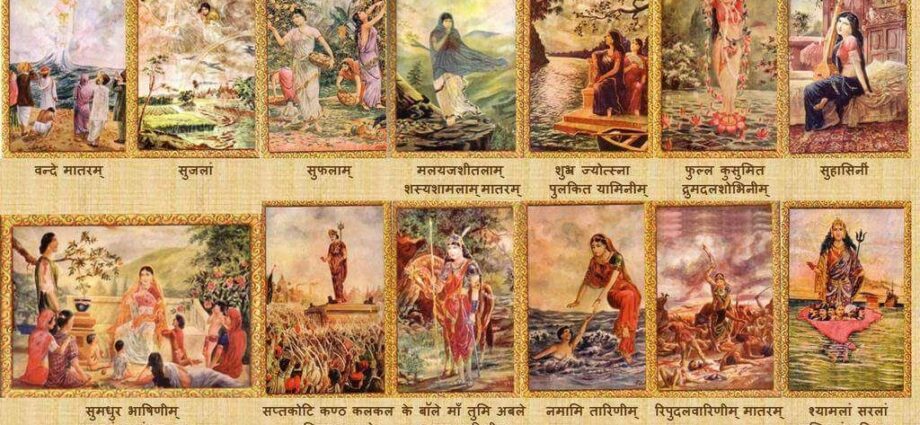After the first war of independence in 1857, the British had established themselves as the sole master of the destiny of India. Around 1870, they even started forcing their anthem, God Save the Queen, on Indians. However, fate had its own way.
A Bengali man named Bankim Chandra Chatterjee was returning home from his office in a palanquin one gummy evening of 1873. On the road, one Colonel Duffin was playing cricket when he was disturbed by the palanquin. Angered with such a nasty act of disturbing his game by a lowly Indian, Duffin pulled out Bankim and rained a few punches on him. Humiliated by such public beatings, he moved court. This event in itself was news: A brown man dragging a white to the court! More surprisingly, the court forced the Colonel to publicly tender an apology to Bankim Chandra. The audience erupted in joy as the Colonel pleaded for forgiveness. Bankim’s insult had now become a public humiliation for a high-ranking British commander. Duffin then hatched a conspiracy to murder him to avenge his public humiliation. Bankim fled the city and took shelter in the neighbouring principality. Here he was impressed with the beautiful idols of Durga and Kali. From this spiritual-intellectual-colonial cocktail, Vande Mataram took birth.

Bankim Chandra Chatterjee composed Vande Mataram, a poem in Sanskritized Bengali in 1875 in one sitting, which he later incorporated in his 1882 path-breaking Bengali novel Anandmath. ‘Vande Mataram’ means “I pray to the mother or motherland”, interpreted as Bharat Mata though the poem does not mention her explicitly. Later, Jadunath Bhattacharya set the poem’s music to Desh Raga Malhar.

Rabindranath Tagore sang it first during the 1896 session of the Indian National Congress, and since then, it has played a crucial part in the Indian independence struggle. By 1905, it became a war cry for the freedom fighters. Viceroy Curzon outlawed the song and the novel, but the general public ignored the restriction and consequently, many were jailed repeatedly for singing it in public. The police unleashed a brutal lathi-charge on the volunteers during a historic session of the Bengal Provincial Conference held in Barisal in April 1906, under the presidency of Shri A. Rasul, and forcefully ripped off the “Vande Mataram” badges worn by them. Some delegates were battered so severely that they collapsed while yelling “Vande Mataram”. In 1906, a gramophone company called Pathephone came up with new sound recording technology in which the recorded voice was crystal clear. The company went on to advertise its product with Vande Mataram. The British destroyed every record containing the song. One copy somehow survived and it was gifted to Indira Gandhi in 1966. By 1920, such was its popularity that it was translated into every major Indian language and consequently, every Hindu across the length and breadth of the country was bubbling with josh.
However, as is customary for Muslims, they regard everything associated with the Hindus to be blasphemous for them. No wonder this song was also found idolatrous. Syed Ali Imam, addressing as President of the All India Muslim League during its Second Session in December 1908, stated:
I cannot say what you think, but when I find the most advanced province of India put forward the sectarian cry of ‘Bande Mataram’ as the national cry, and the sectarian Rakhi-bandhan as a national observance, my heart is filled with despair and disappointment; and the suspicion that, under the cloak of nationalism, Hindu nationalism is preached in India becomes a conviction.
He was alluding to the Rakhi Bandhan event of 1905, which Rabindranath Tagore called to create brotherhood amongst the Hindu and Muslim populations in opposition to Curzon’s division of Bengal. The decision to divide Bengal was made in Assam in June 1905, when Muslims expressed the need for a separate state to preserve their identity. For the selfish agenda of the British, the Hindu majority provinces of West Bengal, Bihar, and Odisha were split from the Muslim-dominated portions of East Bengal, Assam and Sylhet.
While presiding over the Congress session in Kakinada in 1923, Maulana Muhammed Ali led the first public protest against the song’s performance. To appease the party’s Muslims, Congress enforced the singing of Muhammad Iqbal’s ‘Sare Jahan se Achha.’ Nehru, a closet Muslim, was equally irked by the Vande Mataram. He wrote to Tagore in 1937: It does seem that the song is likely to irritate the Muslims. Post-1930, Nehru grew in stature; his popularity rivalled Gandhi and he became increasingly dictatorial.
Not wanting to be left behind in the vociferous protests, Jinnah, too, expressed his reservations. While refusing to adopt Vande Mataram, he wrote in The New Times of Lahore (March 1, 1938):
Muslims all over [India] have refused to accept Vande Mataram or any expurgated edition of the anti-Muslim song as a binding national anthem.
The Sikh communities in Punjab also advised against playing the song at Khalsa schools, while surprisingly, Christians praised it.
The debate intensified when the national anthem was being decided. Vande Mataram was an obvious option due to its popularity and critical role in the freedom movement, but the last half of the hymn raised concerns in the minds of Congress members. To select a national anthem, an informal committee comprising Tagore, Nehru, and Subhash Bose started scouting for the anthem. Bose expressed his fears in a letter to Tagore in 1937 that if the committee rejected the song, it would go against the feelings of Hindus in Bengal. The correspondence with Tagore demonstrates how everyone turned to him for answers as he was the first to sing it in a Congress session. Tagore responded that the poem’s placement in the novel might be ‘accidental’, but the first two stanzas had achieved immortality due to devotion exhibited towards Mother India. The first two verses of the hymn are an abstract allusion to mother and motherland as they do not mention any Hindu deity by name, in contrast to subsequent verses that do. Hence, he believed that the entire song would offend Muslims, but only the first two verses won’t. Tagore was trolled for this stance and was perturbed by such abuse, though he kept a straight face in public.
When no decision could be taken, a sub-committee was formed comprising Abul Kalam Azad, Nehru, Bose, and Narendra Dev to examine all current national songs that were submitted to it. The sub-committee would choose a collection of songs from among those offered and present it to the Congress Working Committee (CWC) for consideration as worthy of inclusion in a pool of national songs. Only songs written in plain Hindustani or that may be adapted to it, with a piece of rousing and uplifting music, would be considered for examination by the sub-committee. The subcommittee would consult and consider suggestions of Tagore.
The committee laid down a few desired features for the anthem: It should be evocative enough to rouse the feelings of citizens. A Government of India publication tells us more about the needs of anthem:
A Constitution, a Flag and an Anthem sum up a nation. Not every song can be the national anthem, whatever its literary qualities. Not every song can be a national anthem, whatever its literary qualities. In fact there are very few national anthems whose merit is exclusively literary. What is it, then, that distinguishes a national anthem? Its “singability”, experts say, among other things: that is, people should be able to sing it in chorus. How can the whole nation sing it unless it is accessible to everybody? A National anthem, besides its “singability,” has, of course, other features also. For instance, it should be distinctly national in sentiment.
In the end, only two songs were left in the fray. It would also be fair to claim that Tagore might have been a bit prejudiced because his “Jana Gana Mana” was also under consideration, and naturally, he would have wanted his song to become the national anthem. On top of that, allegations were swirling around that he wrote it in praise of the British King George the fifth. It was sung for the first time on the second day of the Calcutta Conference of the Congress in December 1911, held specially to give royal thanks to the king for annulling the partition of Bengal.
In a letter to Bose, Tagore’s views were even more obvious. He wrote, “The core of Vande Mataram is a hymn to goddess Durga: this is so plain that there can be no debate about it. Of course, Bankim does show Durga to be inseparably united with Bengal in the end, but no mussalman can be expected patriotically to worship the ten-handed deity as a nation.” As a result, Congress in 1937, always extra-sensitive to the needs of the Muslims but still wanting the immensely inspiring Vande Mataram to be a part of its tradition, decided that only the first two non-controversial stanzas would be sung during its sessions. The last three stanzas were summarily dropped. The rendition of Vande Mataram is now for 65 seconds, while “Jana Gana Mana” is for 52 seconds.
Mahatma Gandhi saw the song from a secular prism as usual. While expressing tremendous admiration for the song and its significance in the independence movement, he insisted that it should not be the source of community animosity. He reached out to Muslims to tell its historical relevance while cautioning against any imposition – a call for mutual tolerance. On the contrary, he held Allah-o-Akbar “a cry than which a greater one had not been produced in the world.”
On January 24, 1950, the Constituent Assembly of India finally declared “Jana Gana Mana” as the anthem and “Vande Mataram”, the national song of India. On this occasion, India’s first President, Rajendra Prasad, remarked that the song would be honoured alongside the national anthem. However, the constitution does not have any reference to “national song”.
All along, an evocative song could not achieve its illustrious heights just to appease a particular religious group. It is an altogether different matter that hapless Hindus in their own country continue to be bludgeoned by cacophonic renditions five times a day.
Source: Sabyasachi Bhattacharya, Vande Mataram, the Biography of a Song.
Written by Amit Agarwal, author of the bestseller on Indian history titled “Swift horses Sharp Swords”. The book is available at the following link:
https://www.amazon.in/gp/product/B08KH3R4MN
https://www.amazon.in/dp/9355788266 (Hindi)
https://www.flipkart.com/swift-horses-sharp-swords/p/itm8c52d865c29bb?pid=9789354165214
Twitter handle @amit1119 Instagram/ Facebook – amitagarwalauthor
![]()
- How Hindu rituals spawned numerous advancements in science, maths and other arts - March 13, 2024
- Naga Sadhus and their fighting skills - February 20, 2024
- Lessons for India from the Israel-Palestine conflict - October 12, 2023

